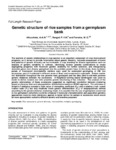Use este identificador para citar ou linkar para este item:
http://www.alice.cnptia.embrapa.br/alice/handle/doc/217667Registro completo de metadados
| Campo DC | Valor | Idioma |
|---|---|---|
| dc.contributor.author | ALLCOCHETE, A. A. N. | pt_BR |
| dc.contributor.author | RANGEL, P. H. N. | pt_BR |
| dc.contributor.author | FERREIRA, M. E. | pt_BR |
| dc.date.accessioned | 2014-10-18T08:15:57Z | - |
| dc.date.available | 2014-10-18T08:15:57Z | - |
| dc.date.created | 2008-12-22 | pt_BR |
| dc.date.issued | 2008 | pt_BR |
| dc.identifier.citation | Scientific Research and Essays, Lagos, v. 3, n. 12, p. 577-598, Dec. 2008. | pt_BR |
| dc.identifier.issn | 1992-2248 | eng |
| dc.identifier.uri | http://www.alice.cnptia.embrapa.br/alice/handle/doc/217667 | pt_BR |
| dc.description | The analysis of genetic relationships in crop species is an important component of crop improvement programs, as it serves to provide information about genetic diversity. Accurate assessment of levels and patterns of genetic diversity can be invaluable in crop breeding for diverse applications such as analysis of genetic variability in cultivars, identifying diverse parental combinations to create segregating progenies with maximum genetic variability for further selection, and introgressing desirable genes from diverse germplasm into the available genetic base. In this study, three multiplex panels of fluorescent microsatellite markers were used for automated genotyping of 298 rice accessions, part of it collected in different areas of Brazil and conserved in a genbank. Sixteen marker loci distributed throughout the rice genome were genotyped and the data used to estimate pairwise genetic distances between the accessions. A Neighbour-Joining based dendrogram was used as model to define clusters and infer possible genetic structuring of the collection. The analysis of the genetic relationships of these accessions suggested no significant correlation between clustering based on distance data and subpopulaition differentiation based on MCMC approach. The estimates of Wright's F-statistics revealed a high value of inbreeding coefficient (FIS) and a relatively high overall fixation index (FIT) but only moderate levels genetic differentiation (FST) of subpopulations defined according to the genetic distance clustering model. It is possible that the use of germplasm conserved in rice germplasm collections could be enhanced if molecular characterization and population genetics approaches could be more intensively applied to better define the sample of accessions which would be more appropriately suited to different genetic and breeding purposes. | pt_BR |
| dc.language.iso | eng | eng |
| dc.rights | openAccess | eng |
| dc.subject | Microssatélite | pt_BR |
| dc.subject | Genetic diversity | pt_BR |
| dc.subject | multiplex genotyping | pt_BR |
| dc.title | Genetic structure of rice samples from a germplasm bank. | pt_BR |
| dc.type | Artigo de periódico | pt_BR |
| dc.date.updated | 2014-10-18T08:15:57Z | pt_BR |
| dc.subject.thesagro | Arroz | pt_BR |
| dc.subject.thesagro | Oryza Sativa | pt_BR |
| dc.subject.thesagro | Variação Genética | eng |
| dc.subject.thesagro | Banco de Germoplasma | eng |
| dc.subject.nalthesaurus | rice | pt_BR |
| riaa.ainfo.id | 217667 | pt_BR |
| riaa.ainfo.lastupdate | 2014-10-17 | pt_BR |
| dc.contributor.institution | A. A. N. ALLCOCHETE, UNIVERSIDADE AGOSTINHO NETO, LUANDA-ANGOLA; PAULO HIDEO NAKANO RANGEL, CNPAF; MARCIO ELIAS FERREIRA, CENARGEN. | pt_BR |
| Aparece nas coleções: | Artigo em periódico indexado (CNPAF)  | |
Arquivos associados a este item:
| Arquivo | Descrição | Tamanho | Formato | |
|---|---|---|---|---|
| alcoc.pdf | 1.62 MB | Adobe PDF |  Visualizar/Abrir |









